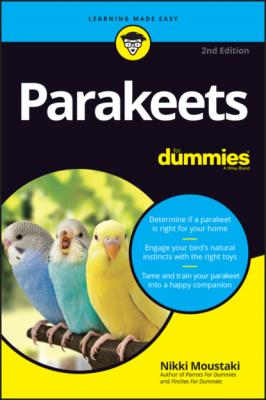ТОП просматриваемых книг сайта:
Parakeets For Dummies. Nikki Moustaki
Читать онлайн.Название Parakeets For Dummies
Год выпуска 0
isbn 9781119755302
Автор произведения Nikki Moustaki
Жанр Биология
Издательство John Wiley & Sons Limited
FIGURE 2-1: Children and parakeets can be good friends, but they must be supervised.
Knowing how much keeping a parakeet will cost
All the parakeet accessories that you’ll need to get started, like a proper cage, cups, toys, and a play-gym, can take a chunk out of your wallet. A parakeet can cost anywhere from $10 to $25 for an American parakeet, or $45 to $100 or more for an English budgie.
Then there are trips to the avian veterinarian for well-bird checkups, which you should do yearly. When your avian veterinarian gets to know your bird, he or she will be better able to take care of it in the event of an accident or illness.
Parakeets cost around $15 per month in food and accessories. You may want to splurge now and then on extra toys or treats, which will bring the total expense higher.
Considering your other family members
If you’re thinking about bringing a parakeet into your home, you owe it to the parakeet and the current residents — whether animals or humans — to think about how everyone will (or won’t) get along.
Parakeets should not be allowed around babies. Parakeets often carry diseases that are communicable to people with under-developed or compromised immune systems, which include babies. Though toddlers have a stronger immunity, they may not understand that they have to be gentle with such a fragile bird.
Even kids that are a little bit older can harm the bird when the parent isn’t looking. The child can let the bird out of the cage, try to catch it, or feed it something harmful. When you get a parakeet for a child (or have a child in the home), make sure that the child is mature enough to understand this animal’s needs, and be sure to supervise your child’s contact with the bird.
Sometimes buying a bird that looks very ill is tempting. Perhaps he’s the most plucked, sorriest looking parakeet of the bunch. The bird looks like it’s going to keel over any second. You know the bird I’m talking about — the one who’s hearing the angels singing already.
This bird is not only going to cost you a fortune in veterinary bills, it may infect your other birds with whatever illness it has, and the pet store is just going to buy another sorry bird to put in his place. You’re always better off sticking with healthy birds from the beginning. Of course, if you know what you’re getting into from the beginning by helping a sick parakeet, by all means do it, just be very careful.
If you feel really sorry for the parakeets in a particular pet store, you aren’t obligated to go into that pet store anymore — and for goodness’ sake, don’t buy birds there. You can call your local Humane Society and hope that something gets done about the conditions in the store. You may want to call the store’s owner as well — that usually works for a time.
One, Two — or More: Increasing Your Parakeet Population
If you want a sweet parakeet that lives for seeing you come home every day, a parakeet who is so enamored with you that you can barely move without it stuck to you like a burr, you’ll want to have one — and only one — parakeet. If you get a pair of parakeets, they may want to interact only with each other, seeing you as an intrusion in their birdy love.
On the other hand, if you lead a busy life and you’re not home for many hours of the day, you may want to consider getting a pair.
Can you have three or more parakeets in a cage? If they are all males, you have a better chance that they will get along. Although female parakeets are more likely to argue and squabble, three females can live together too if they are all housed in a very large cage, flight, or aviary at the same time. If you have a true pair, a bonded male and a female, you don’t want to add another bird unless you have a very large flight cage at least six feet in length to allow a pursued “rival” adequate space to escape, or else the existing pair may become territorial and can severely injure the “intruder,” or worse.
Two parakeets interacting can be really cute if they like each other. They will sit together and preen each other. The male will do a little mating dance, strutting up and down the perch, rapidly tapping his beak against the perch or a shiny object. They will chitter-chatter to each other. These behaviors are all ways in which parakeets communicate.
Giving a parakeet as a gift isn’t a great idea unless you have discussed it with the recipient and the gift isn’t a surprise. You may think that you’re giving a parakeet, but what you’re really giving is a 12-year or more responsibility with a bird that the person may not like — and vice versa. Take into consideration that the person may have wanted to choose the parakeet on his own. Maybe you got him a blue parakeet and he wanted a yellow one. A gift certificate to a pet shop is a better option if the recipient has indicated that they really want a parakeet.
Remember: Holidays are the worst time to give a live animal to anyone. Holidays are traditionally busy times with

